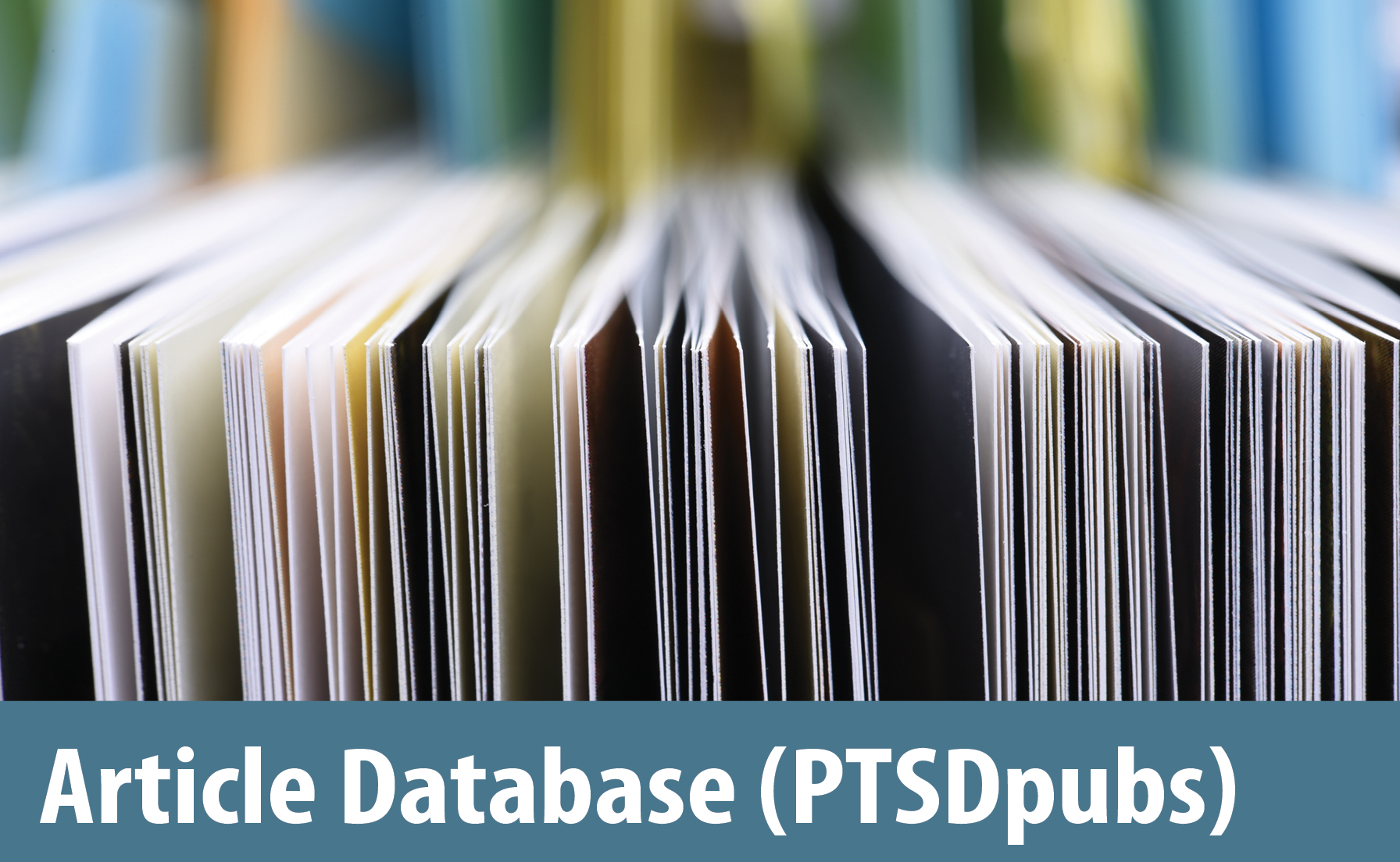PTSD: National Center for PTSD
Psychological Trauma for American Indians Who Served in Vietnam
Psychological Trauma for American Indians Who Served in Vietnam
The Matsunaga Vietnam Veterans Project
Military personnel of many ethnic backgrounds served with distinction in the Vietnam War. The 1988 National Vietnam Veterans Readjustment Study (NVVRS)(1) demonstrated that Black and Hispanic Veterans who served in Vietnam experienced significantly greater readjustment problems and higher levels of Posttraumatic Stress Disorder (PTSD) than White Veterans.
To extend the study to other minority Veterans, the late Senator from Hawaii, Spark Matsunaga, initiated a major project to assess the readjustment experiences of American Indian, Japanese American, and Native Hawaiian Veterans of the Vietnam War. This resulted in Public Law 101-507, which directed the VA's National Center for PTSD to conduct what became known as the Matsunaga Vietnam Veterans Project.(2)
The Matsunaga Project involved two parallel studies. The American Indian Vietnam Veterans Project surveyed a sample of Vietnam in-country Veterans residing on or near two large tribal reservations, one in the Southwest and the other in the Northern Plains. These populations had sufficient numbers of Vietnam military Veterans to draw scientifically and culturally sound conclusions about the war and readjustment experiences.
In This Article
The Hawaii Vietnam Veterans Project surveyed two samples, one of Native Hawaiians (the indigenous peoples of the Hawaiian Islands, who constitute about 22% of the permanent population in Hawaii) and another of Americans of Japanese Ancestry (the descendants of Japanese immigrants who comprise about 24% of the permanent population in Hawaii).
Matsunaga study participants were interviewed face-to-face for several hours with culturally sensitive questions about their prewar and war experiences; their PTSD and other health problems; their personal, family, work, and education readjustment experiences; and their use of Veterans Affairs health care services. Only men participated because, despite their key contributions to the military, there are few women Vietnam Veterans in these survey populations. Although many American Indian Veterans from other tribes and areas of the United States served in Vietnam, in a single study it is not possible to characterize every possible American Indian tribe or Veteran. The many American Indian experiences and cultures all require recognition and respect. The similarities and differences revealed by surveying hundreds of Vietnam Veterans from each of two large and different tribes bring to life the richness and diversity of the American Indian experience before, during, and after the Vietnam War.
The Matsunaga Study's key finding is that exposure to war zone stress and other military danger places Veterans at risk for PTSD several decades after military service. Native Hawaiian and American Indian Vietnam in-country Veterans had relatively high levels of exposure to war zone stress and high levels of PTSD. Caucasian and Japanese American Veterans tended to have somewhat lower levels of exposure to war zone stress and later PTSD.
The unique cultural traditions, society, and family experiences of each different ethnic group played an important role in the Veteran's homecoming and readjustment after Vietnam, but they do not appear to either cause or prevent PTSD.
American Indian Veterans' Experiences Before and During the War
"I was a happy, healthy boy, and I felt in harmony with my family, my people, and the earth because of the teachings my grandfather shared in traditional ceremonies and that my father shared when we'd go fishing. I grew up in a hurry when I enlisted in the Marines after high school, and I hated being looked down on as an Indian. I had to swallow the anger and shame when they jokingly called me Chief. Nothing prepared me for the physical and spiritual violation of war. I stayed for three tours because I lived so much with death that I couldn't come home."
Before military service
American Indian Veterans described growing up in a supportive tribal community, on or off reservation, in which they felt securely included in their extended families and close to their parents. They rarely recalled physical abuse, less so than any other ethnic group except Japanese Americans. They and their families were very involved in traditional activities such as tribal gatherings and ceremonies, and they learned to trust and honor traditional values. These men often attended and completed school and were actively involved with their peer group and in organized activities such as athletics. Disciplinary or legal problems were rare. However, many experienced the stressor of adult members of their families who suffered from substance abuse or PTSD.
Entering military service
American Indian Veterans often joined the military as a way to obtain opportunities for education, jobs, and travel not otherwise available to them.
In addition to wanting to serve their country, many wanted to become warriors to protect their families, to uphold the honor of their tribes, and to prove themselves as men. Military training was a shocking new experience with good and bad aspects. For the good, many found the discipline, skills, and team spirit an invaluable preparation both for war and later adulthood.
On the other hand, many felt torn between traditional spiritual and community values and the military emphasis on aggression and killing. Many faced racial prejudice and discrimination, often for the first time up close, and felt disillusioned when they or other Indians encountered racial hostility or disrespect.
More than one in two American Indian Veterans experienced war-related trauma in Vietnam. The war traumas included being on frequent or prolonged combat missions in enemy territory; encountering ambushes and firefights; being attacked by sappers, snipers, artillery, or rockets; and witnessing death and terrible harm to their own or others' bodies. Traumas also included being under fire on helicopters, cargo and reconnaissance aircraft, patrol boats, and cargo trucks and being on very hazardous duty such as walking point or being a radio operator, medic, scout, tunnel rat, perimeter sentry, long range patrol, or door gunner.
American Indians faced war trauma so often for many reasons, including because they were more likely than any other ethnic group to serve in the Marines (the branch of service with most combat duty) and in the northernmost sector of Vietnam (I-corps, the area under greatest enemy attack).
American Indians and Native Hawaiians received combat service medals more often than individuals in other ethnic groups.
American Indian Veterans' Homecoming and Readjustment Experiences
"I was spit on and called a baby-killer in the mainstream culture when I first came home, and no way any college would accept me or any good job would be open to me. I felt too ashamed and enraged to accept the love and gratitude my family and community showed me. I thought I was going crazy, waking up in a sweat trying to choke my wife, seeing signs of Charley around every corner when the weather was hot and steamy. I'd always kept my feelings to myself, but now I didn't seem to have any feelings except anger. I couldn't get through a day without getting into a fight, and when I tried to numb the pain with alcohol I just got more angry and out of control. I left my wife and kids because I was ashamed and afraid of what I was doing to them, but I miss them still. I've had more jobs than I can count, and I walked out on every one because I'd start to feel trapped. I really never left Vietnam until just a couple of years ago after I got sober in a program, and then I felt I had to either go back to my tribe and go through the healing ceremonies or I was going to kill myself. I'm finally beginning to come home, with the help of a Vet Center counselor and the Blessing Way in my community."
The long journey home
Many Veterans are unable to leave behind the trauma of Vietnam and psychologically return home. What neither these Veterans nor their families (nor even many VA counselors and doctors) knew was that many of these Veterans were and are suffering from PTSD. For more information about PTSD, see PTSD Overview.
About one in three American Indian Vietnam Veterans who served in-country suffered from full or partial PTSD at the time of the study, a quarter century or more after the war. More than two in three American Indian Vietnam Veterans suffered from full or partial PTSD sometime since Vietnam. PTSD prevalence for American Indians is very high, more than twice as high as for White or Japanese American Vietnam Veterans.
PTSD's effect on family and friendships
American Indian Vietnam Veterans reported the most severe problems of any ethnic group in the NVVRS or Matsunaga Project. They tended to be extremely isolated from relationships and community, primarily as a result of PTSD. The Northern Plains Veterans were by far the most likely of any study group, including Southwest tribal Veterans, to have been verbally hostile in the recent past, to have been homeless or vagrant, to have been divorced once or several times, and to have had problems as a parent. PTSD explains much of these interpersonal problems. In addition, the Northern Plains Veterans had great difficulty in rejoining the very tightly knit extended families and communities of their tribes after the war. For example, only one in seven of these Veterans had participated in a traditional healing ceremony, compared to one in two Southwest Indian Veterans.
Other people, such as spouses, children, family members, friends, or coworkers, often are more aware of the Veteran's emotional distress than he is himself. Decades of haunting memories and overwhelming feelings leave the Veteran suffering from PTSD feeling demoralized and alone. He may believe that as a man he must bear the burden of pain, fear, anger, shame, and guilt silently. He may believe that he has failed his most precious loved ones and lost the respect of his community. He may feel helpless to conquer the habitual urge to drink alcohol. As a result, it becomes almost impossible for him to enjoy life or relationships, and the harder he tries to fight the symptoms the more stressed he becomes! Yet, when family or friends see signs of the Veteran's inner turmoil, they don't know why it's happening and often blame themselves: "I always thought it was something I was doing wrong, but I never knew what!" Nor do they know how to help: "I gave up trying to break through his emotional walls."
The family's view of PTSD may include:
- "Little things get him very depressed or enraged, like he's always at the end of his rope."
- "He tries to enjoy being with us, but his heart's not in it and his mind's always somewhere else."
- "For him, every problem's a disaster, and we're slow, stupid, and never careful or tough enough."
- "He's always got to be on the go, can never sit still, and can't even hold the same job for long."
- "I never understood why he kept going back to alcohol, even though he always ends up in a fight, in jail, or out in the mountains for weeks after he's been drinking. He won't stop even though it's killing him."
PTSD's effect on work and education
Getting and keeping a good job, or returning to complete school or for advanced education, require exactly the abilities that are most impaired by PTSD: mental concentration, managing anger, solving problems without turning them into crises, communicating clearly, balancing work with relaxation, and feeling a sense of hopefulness and purpose. Despite courageous efforts, Veterans with PTSD often become trapped in the vicious cycle of settling for bad jobs and avoiding or walking out on good jobs. Now well into their 40s and 50s, Vietnam Veterans with PTSD face great difficulty in getting a good education or having a rewarding career. Of all survey groups, the Northern Plains Veterans have had the most difficulty keeping jobs, mainly because they also were the most likely to suffer from PTSD.
PTSD's effect on addiction
Over 70% of the American Indian Vietnam Veterans have current serious problems with alcohol overuse or dependence, more than twice as many as any other group in the NVVRS or Matsunaga Project. Addiction to any drug other than alcohol, however, was not a greater problem for American Indian Veterans than for other Veterans. PTSD plays a substantial role in these Veterans' alcohol problems, but the discrimination, isolation, and demoralization experienced by Native American civilians and Veterans is also a factor. Alcohol is a tempting (false) solution to PTSD symptoms such as nightmares ("drink yourself into a dreamless stupor"), unwanted memories and fears ("drink until your mind is blank"), anger and tension ("drink to take away the edge"), hopelessness and emotional numbness ("drink until you feel no pain"), and hyper-vigilance ("drink until you don't care anymore"). Unfortunately, excessive habitual use of alcohol causes a person to feel edgy, irritable, unable to concentrate, and more demoralized than ever.
PTSD's effect on physical health
American Indian Vietnam Veterans reported the poorest physical health and the highest level of medical care use of any NVVRS or Matsunaga Project group. This may be partly due to chronic alcohol overuse, which often is associated with smoking and poor health habits. However, PTSD also plays a role in poor physical health. PTSD symptoms such as restlessness, tension, irritability, anxiety, and poor sleep are exhausting and hard on the body. Culturally, it also may be more acceptable to disclose somatic problems and pains to family or medical providers than to admit emotional distress. Physical illness more often results in sympathy and concern, while emotional distress may be mistakenly viewed (by the Veteran, his family and community, or the medical provider) as a sign of weakness or lack of character. In fact, the emotional distress and poor physical health associated with PTSD are both signs of a legitimate need for traditional healing and mainstream medical and mental-health care.
References
- Kulka, R.A., Schlenger, W.A., Fairbanks, J.A., Hough, R.L., Jordan, B.K., Marmar, C.R., Cranston, A.S. (1990). Trauma and the Vietnam War generation: Report of findings from the National Vietnam Veterans Readjustment Study. New York: Brunner/Mazel.
- Friedman, M.J., Ashcraft, M.L., Beals. J.L., Keane, T.M., Manson, S.M., & Marsella, A.J. (1997). Matsunaga Vietnam Veterans Project (Volumes 1 and 2). National Center for Posttraumatic Stress Disorder and National Center for American Indian and Alaska Native Mental Health Research.
You May Also Be Interested In

Continuing Education Online Courses
Learn from expert researchers and earn free Continuing Education (CE) credits.

























